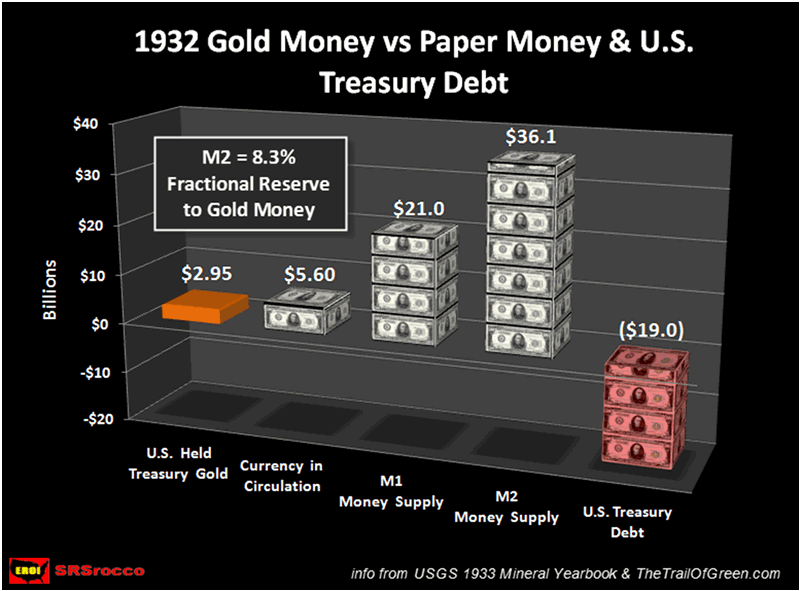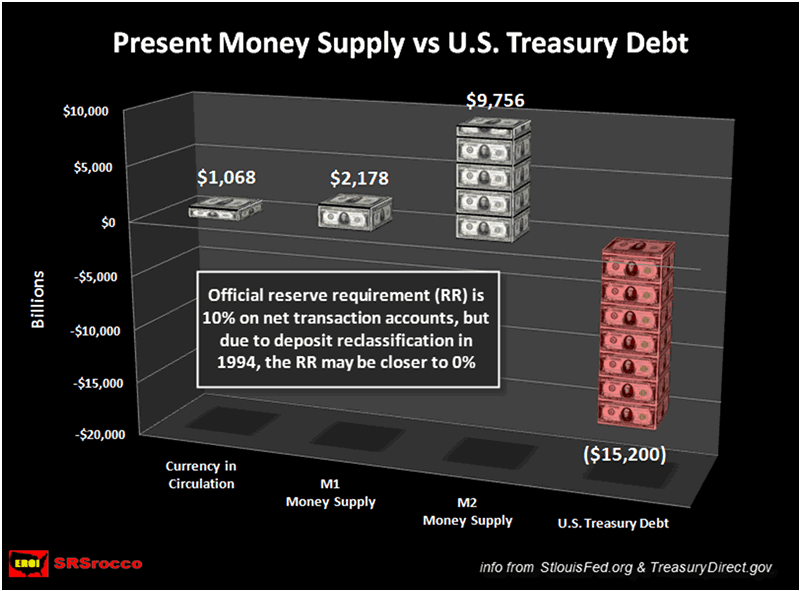"...Eric Sprott made a recent comment posted in an article on Zerohedge.com, stating that “The financial system is a farce” . He couldn’t be more correct in his assumption. Not only is the present U.S. banking system based on a financial debt instrument called a Federal Reserve Note, but its fractional reserve ratio is virtually nonexistent.
In 1932, the United States had a fractional reserve banking system backed by gold. The member banks had different reserve requirements: central reserve city banks (13 percent), reserve banks (10 percent) and country banks (7 percent). All member banks had a 3 percent reserve requirement on time deposits. Even with these official reserve ratios, the total paper dollar claims to gold were much higher. For this analysis, we are going to compare the M2 money supply to the amount of U.S. Treasury-held gold.

In 1932, the U.S. Treasury held $2.95 billion in gold, there was $5.60 billion in currency in circulation, $36 billion in M2 money supply, and $19 billion in U.S. Treasury debt. The fractional reserve of gold to the M2 money supply was 8.3%.
Despite the terrible conditions during the “Great Depression”, at least the country had two positive factors going for it: 1) A banking system backed by gold and 2) vast resources of energy, metals and minerals to tap into to pull itself out of its current market ills.
Today, the banking system is on the verge of collapse and the country has consumed its best resources which peaked 40-50 years ago. After Nixon dropped the dollar peg to gold in 1971, the world has been on a floating exchange rate fiat monetary system. The present fractional reserve banking system we have today is based on a fiat paper reserve.

This graph shows that no gold whatsoever is backing up the banking system. As the U.S. banking system stands today, its currency— the Federal Reserve Note— is backed by $15.2 trillion worth of U.S. Treasury debt. The system is even weaker when we look into the makeup of the banks’ fractional reserve ratio..."
at http://www.marketoracle.co.uk/Article32876.html
In 1932, the United States had a fractional reserve banking system backed by gold. The member banks had different reserve requirements: central reserve city banks (13 percent), reserve banks (10 percent) and country banks (7 percent). All member banks had a 3 percent reserve requirement on time deposits. Even with these official reserve ratios, the total paper dollar claims to gold were much higher. For this analysis, we are going to compare the M2 money supply to the amount of U.S. Treasury-held gold.

In 1932, the U.S. Treasury held $2.95 billion in gold, there was $5.60 billion in currency in circulation, $36 billion in M2 money supply, and $19 billion in U.S. Treasury debt. The fractional reserve of gold to the M2 money supply was 8.3%.
Despite the terrible conditions during the “Great Depression”, at least the country had two positive factors going for it: 1) A banking system backed by gold and 2) vast resources of energy, metals and minerals to tap into to pull itself out of its current market ills.
Today, the banking system is on the verge of collapse and the country has consumed its best resources which peaked 40-50 years ago. After Nixon dropped the dollar peg to gold in 1971, the world has been on a floating exchange rate fiat monetary system. The present fractional reserve banking system we have today is based on a fiat paper reserve.

This graph shows that no gold whatsoever is backing up the banking system. As the U.S. banking system stands today, its currency— the Federal Reserve Note— is backed by $15.2 trillion worth of U.S. Treasury debt. The system is even weaker when we look into the makeup of the banks’ fractional reserve ratio..."
at http://www.marketoracle.co.uk/Article32876.html